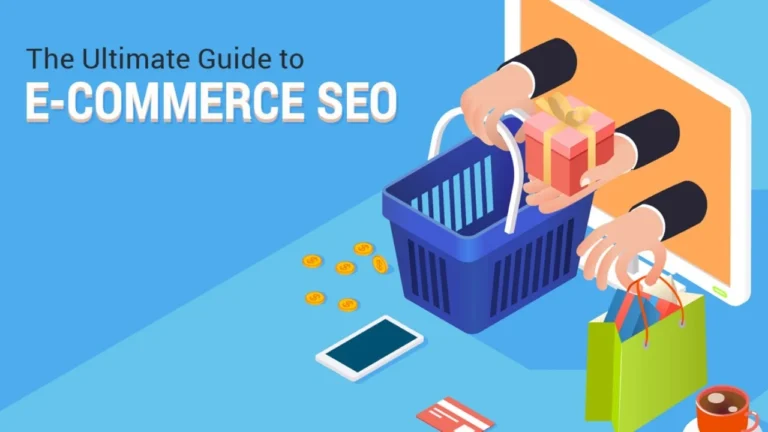Did you know that 43% of all ecommerce traffic comes from organic Google searches? That means nearly half of online shoppers find products through search engines before making a purchase. If your online store isn’t optimized for search engines, you’re missing out on potential customers and revenue.
This guide will walk you through the essentials of Ecommerce SEO, covering everything from keyword research to technical optimizations and content marketing strategies to help you outrank your competitors and drive sales.

What is Ecommerce SEO?
Ecommerce SEO is the process of optimizing your online store to improve its visibility in search engine results. Unlike traditional SEO, ecommerce SEO focuses on product pages, category pages, and transactional intent keywords to attract shoppers who are ready to buy.
Why is Ecommerce SEO Important?
Higher Organic Traffic – Unlike paid ads, SEO brings in consistent, free traffic.
Increased Conversions – Search engine visitors are more intent-driven than social media users.
Better User Experience – Optimizing for SEO improves site speed, navigation, and usability.
Long-Term ROI – SEO efforts compound over time, providing a sustainable traffic source.
Step 1: Keyword Research for Ecommerce SEO
Keyword research is the foundation of any successful ecommerce SEO strategy. Your goal is to find high-intent, transactional keywords that potential buyers are searching for.
How to Find the Right Ecommerce Keywords
Use tools like:
Google Keyword Planner – Great for discovering search volume and competition levels.
SEMrush – Provides competitor keyword analysis and keyword difficulty scores.
Ahrefs – Helps you find long-tail keywords that are easier to rank for.
Types of Ecommerce Keywords to Target
| Keyword Type | Example |
|---|---|
| Transactional Keywords | “Buy running shoes online” |
| Product-Specific Keywords | “Nike Air Zoom Pegasus 40 review” |
| Category Keywords | “Best budget laptops 2025” |
| Long-Tail Keywords | “Best skincare routine for acne-prone skin” |
Pro Tip: Focus on long-tail keywords because they have lower competition and a higher conversion rate.
Step 2: Optimizing Product & Category Pages
Product Page Optimization Checklist
SEO-Friendly Product Titles – Use primary keywords naturally in titles.
Unique Product Descriptions – Avoid manufacturer descriptions. Write original, keyword-rich descriptions.
High-Quality Images & Videos – Optimize images for fast loading and use alt text.
Schema Markup – Add structured data for rich snippets like ratings, price, and availability.
Customer Reviews & Ratings – Improves trust and click-through rates (CTR).
Category Page Optimization
Use Descriptive H1 & H2 Tags – Include target keywords in headers.
Optimize Meta Titles & Descriptions – Keep them compelling with CTA-driven language.
Internal Linking – Link to related categories and product pages to improve SEO structure.
Step 3: Technical SEO for Ecommerce
Key Technical SEO Factors
Site Speed Optimization – Google prioritizes fast-loading websites (Google PageSpeed Insights).
Mobile-Friendliness – Ensure your store is responsive and loads well on all devices.
Secure HTTPS Connection – Google ranks secure sites higher.
Canonical Tags – Prevent duplicate content issues by pointing Google to the preferred version of a page.
XML Sitemap & Robots.txt – Helps Google crawl your ecommerce site efficiently.
Step 4: Content Marketing for Ecommerce SEO
Why Ecommerce Brands Need a Blog
Companies that blog generate 67% more leads per month than those that don’t.
Best Blog Topics for Ecommerce Websites
Product Comparisons – “Nike vs. Adidas Running Shoes: Which One is Best?”
How-To Guides – “How to Choose the Right Skincare for Your Skin Type”
Gift Guides – “Top 10 Gift Ideas for Tech Lovers”
Step 5: Link Building for Ecommerce SEO
How to Get Backlinks for Your Store
Influencer Collaborations – Partner with bloggers & YouTubers in your niche.
Guest Posting – Write articles for high-authority websites.
HARO (Help a Reporter Out) – Get featured in news articles.
Broken Link Building – Find and replace broken links with your content. Learn more about link building strategies that can help your ecommerce store rank higher.
Why Choose CG Marketing for Ecommerce SEO?
At CG Marketing, we offer tailored solutions to increase organic traffic and boost ecommerce sales.
SEO Services – Full-scale SEO optimization for your ecommerce store.
WordPress Website Design – Build a high-performance ecommerce website optimized for SEO, speed, and conversions with our expert WordPress development services.
Web Development – Optimized, fast-loading ecommerce sites.
Social Media Marketing – Leverage social platforms to boost brand awareness.
UI/UX Design – Enhance user experience and maximize conversions.
Conclusion: Boost Your Ecommerce Sales with SEO
SEO is the key to driving sustainable growth in ecommerce. By implementing these strategies, you can increase traffic, improve user experience, and ultimately boost sales.
Need a free SEO audit? Start with Zero AED now.
